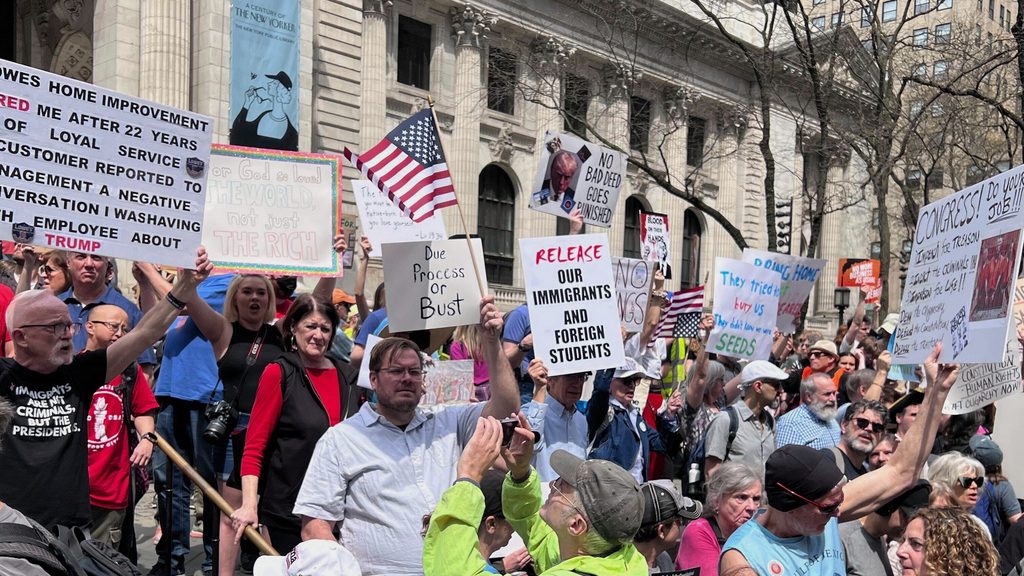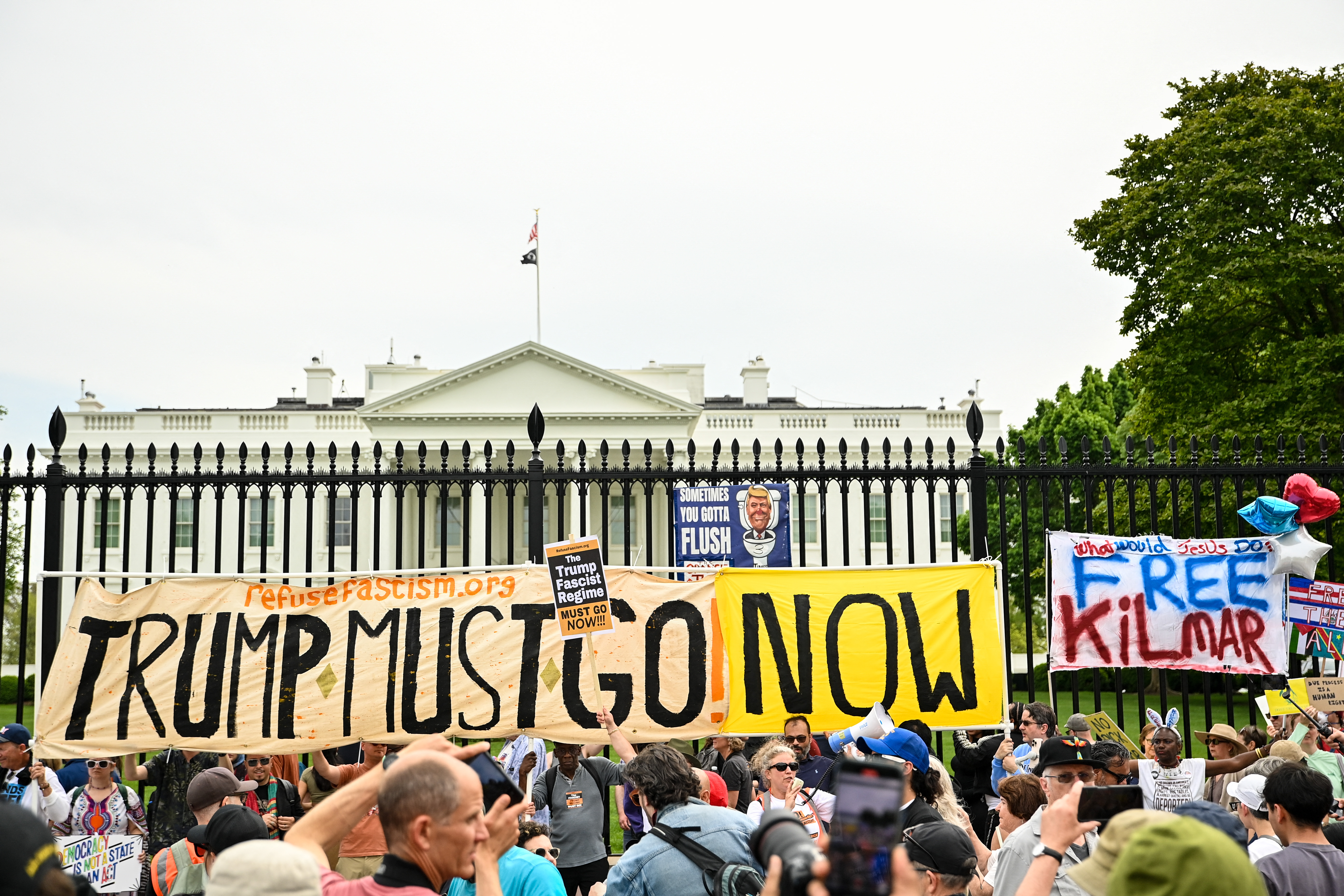Anti-Trump Protests Erupt: Rallies Across US
Nationwide Protests Erupt: Anti-Trump Sentiment Fuels Rallies Across America
Introduction: A Wave of Discontent Sweeps the Nation
The air crackled with dissent this past Saturday as opponents of President Donald Trump's administration poured into the streets, not just in the bustling metropolis of New York City or the political heartland of Washington D.C., but in countless cities and towns across the United States. From coast to coast, a chorus of voices rose, decrying what many perceive as a threat to the very foundations of American democracy. Was this a spontaneous uprising? A carefully orchestrated campaign? The answer, perhaps, lies somewhere in between.
The Spark: What Ignited the Protests?
It wasn't a single event that triggered this nationwide outpouring of emotion. Rather, it was a culmination of policies, pronouncements, and perceived transgressions that, for many Americans, reached a tipping point. The rallies served as a collective release, a tangible expression of anxieties simmering beneath the surface of daily life.
New York City: A March Through Manhattan's Core
Imagine the energy, the sheer scale of it! In the heart of Manhattan, a river of humanity flowed, their voices echoing between skyscrapers, their signs held high in defiance. The march wasn't just a protest; it was a statement, a declaration that the concerns of these individuals couldn't be ignored. Were they heard above the city's cacophony?
Washington D.C.: A Rally at the White House Gates
The nation's capital, a stage for political theater, saw its own share of protest. A rally unfolded in front of the White House, the very symbol of presidential power. This wasn't just about disagreeing with policy; it was about confronting power directly, about voicing concerns at the doorstep of the administration. Can you picture the scene, the emotions running high in such a charged atmosphere?
Boston: Connecting Past and Present
Reenactment and Resistance
In Massachusetts, a commemoration of the Battles of Lexington and Concord, a pivotal moment in the American Revolution, became a backdrop for protest. The historical significance of the event, the "shot heard 'round the world," added another layer of meaning to the demonstrations. Is history repeating itself, in a way? Are Americans once again fighting for their freedoms, but this time against their own government?
Thomas Bassford, an 80-year-old retired mason from Maine, articulated this sentiment powerfully. He believes Americans are currently under attack by their own government and need to resist.
San Francisco: A Message on the Beach
Impeachment Banner on Ocean Beach
On the West Coast, in San Francisco, protesters took a more creative approach. They formed a human banner on the sands of Ocean Beach, spelling out "Impeach & Remove." The message, stark against the backdrop of the Pacific Ocean, was impossible to miss. It's a powerful image, isn't it? A collective message carried by individuals, each playing their part.
The Common Thread: Shared Concerns, Diverse Voices
While the locations and tactics varied, a common thread ran through all these protests: a deep-seated concern about the direction of the country. Whether it was healthcare, immigration, environmental policy, or something else entirely, these protesters felt compelled to make their voices heard. They believed that the nation's democratic ideals were under threat and that action was necessary.
Beyond the Headlines: Individual Stories of Protest
Behind every protest sign, behind every chanted slogan, there are individual stories of frustration, hope, and determination. These are the stories that often get lost in the broader narrative, but they are the heart and soul of any movement. What motivates these individuals to take to the streets? What sacrifices are they making to stand up for what they believe in?
The Role of Social Media: Amplifying the Message
In the age of social media, protests are no longer confined to the physical realm. Images, videos, and messages spread rapidly online, amplifying the impact of these events. Social media can be a powerful tool for organizing, mobilizing, and sharing information. But it also has its downsides, including the spread of misinformation and the potential for online harassment. Is it a blessing or a curse?
The Response: Reactions from the Administration and Beyond
How did the Trump administration respond to these protests? What did other political figures, commentators, and citizens have to say? The answer varied widely, of course. Some dismissed the protesters as a fringe minority, while others praised them for exercising their democratic rights. The protests sparked a national conversation about the state of the country and the future of its democracy. What's *your* take on it?
The First Amendment: The Right to Assemble and Protest
At the heart of these protests lies the First Amendment to the United States Constitution, which guarantees the right to assemble peacefully and to petition the government for a redress of grievances. This right is fundamental to a functioning democracy. But it also comes with responsibilities, including the need to respect the rights of others and to avoid violence. The right to protest is a cornerstone of American freedom.
Looking Ahead: What Does the Future Hold?
What impact will these protests have on the political landscape? Will they lead to policy changes? Will they influence the upcoming elections? It's impossible to say for sure. But one thing is clear: the voices of dissent are growing louder, and the political climate is becoming increasingly polarized. The future is uncertain, but the passion and determination of these protesters suggest that they are not giving up anytime soon. Will this movement gain momentum? Will it fade away? Time will tell.
The Enduring Power of Protest: A Historical Perspective
Throughout American history, protests have played a crucial role in shaping the nation's trajectory. From the Boston Tea Party to the Civil Rights Movement, ordinary citizens have taken to the streets to demand change, to challenge injustice, and to hold their leaders accountable. Protests are not just about expressing anger or frustration; they are about exercising power, about making a difference. Are we seeing the start of a new chapter in the history of American protest?
Local Voices, National Impact
It's easy to get caught up in the big picture, to focus on the national headlines and the political implications. But it's important to remember that these protests are ultimately about local communities, about individuals coming together to address the issues that affect their lives. Each rally, each march, each demonstration represents a microcosm of the larger struggle for justice and equality. Don't underestimate the power of local action; it's where change often begins. What can YOU do in your community?
The Echoes of History: Lessons from Past Protests
We can learn a lot from studying past protests, from understanding the strategies that worked and the mistakes that were made. History offers a valuable perspective, providing context and insights that can inform our understanding of current events. What lessons can we draw from the Civil Rights Movement, the anti-war protests of the 1960s, or the women's suffrage movement? History is a guide, a teacher, a source of inspiration.
Conclusion: A Nation Divided, a Nation Speaking
The anti-Trump protests that swept the nation on Saturday serve as a stark reminder of the deep divisions that exist within American society. These events underscore the importance of civic engagement, the power of collective action, and the enduring relevance of the First Amendment. Whether you agree with the protesters or not, their voices deserve to be heard, their concerns deserve to be considered, and their right to protest deserves to be protected. The future of American democracy depends on it. Remember, a healthy democracy thrives on open debate and the free exchange of ideas.
Frequently Asked Questions (FAQs)
What were the main issues driving the protests?
The protests were driven by a wide range of concerns, including perceived threats to democratic ideals, concerns about specific policies implemented by the Trump administration, and a general sense of unease about the direction of the country. The specific issues varied from location to location, reflecting the diverse concerns of different communities.
How were the protests organized?
The protests were organized through a combination of grassroots efforts, social media campaigns, and established activist organizations. Some events were planned well in advance, while others were spontaneous responses to specific events or pronouncements. The level of organization varied widely.
Were the protests peaceful?
The vast majority of the protests were peaceful. While there were isolated incidents of violence or property damage, these were the exception rather than the rule. Most protesters were committed to exercising their First Amendment rights in a responsible and non-violent manner.
What is the role of social media in these protests?
Social media played a crucial role in organizing, promoting, and amplifying the protests. It allowed activists to connect with one another, to share information, and to mobilize supporters. Social media also provided a platform for sharing images and videos of the protests, which helped to raise awareness and to shape public opinion.
What can I do if I want to get involved in future protests?
If you're interested in getting involved in future protests, there are several things you can do. You can research local activist organizations, connect with like-minded individuals on social media, and attend community meetings or rallies. It's also important to stay informed about the issues that are driving the protests and to understand your rights as a protester.

